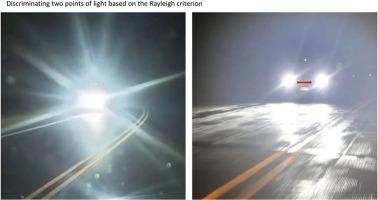The influence of macular pigment on the fine spatial resolution of light of varying wavelengths
IF 2.7
2区 医学
Q1 OPHTHALMOLOGY
引用次数: 0
Abstract
Macular pigments (MP), composed of lutein, zeaxanthin and meso-zeaxanthin, accumulate in the human fovea and selectively absorb short-wavelength light, potentially influencing spatial vision. This study investigated the relationship between macular pigment optical density (MPOD) and fine spatial resolution across different wavelengths under conditions subject to light scatter. Sixty healthy participants (mean age = 22.7 years) underwent MPOD assessment using heterochromatic flicker photometry and performed a two-point resolution task utilizing a custom optical system with monochromatic and broadband light sources. A significant (p<0.05) negative correlation between MPOD and two-point resolution thresholds at shorter wavelengths but not at longer wavelengths suggesting MP enhances spatial resolution specifically for absorbed wavelengths. Quartile analysis, for example, demonstrated that individuals with higher MPOD exhibited 31-38% better spatial resolution at 420-540 nm compared to those with lower MPOD. These findings support the hypothesis that MP selectively mitigates light scatter effects and improves visual function even in low-light conditions.

黄斑色素对不同波长光的精细空间分辨率的影响。
黄斑色素(Macular pigment, MP)由叶黄素、玉米黄质和中玉米黄质组成,在人的中央凹中积累,选择性地吸收短波长的光,可能影响空间视觉。研究了光散射条件下黄斑色素光密度(MPOD)与不同波长精细空间分辨率的关系。60名健康参与者(平均年龄22.7岁)采用异色闪烁光度法进行了MPOD评估,并使用单色和宽带光源定制光学系统进行了2点分辨率任务。显著的(p)
本文章由计算机程序翻译,如有差异,请以英文原文为准。
求助全文
约1分钟内获得全文
求助全文
来源期刊

Experimental eye research
医学-眼科学
CiteScore
6.80
自引率
5.90%
发文量
323
审稿时长
66 days
期刊介绍:
The primary goal of Experimental Eye Research is to publish original research papers on all aspects of experimental biology of the eye and ocular tissues that seek to define the mechanisms of normal function and/or disease. Studies of ocular tissues that encompass the disciplines of cell biology, developmental biology, genetics, molecular biology, physiology, biochemistry, biophysics, immunology or microbiology are most welcomed. Manuscripts that are purely clinical or in a surgical area of ophthalmology are not appropriate for submission to Experimental Eye Research and if received will be returned without review.
 求助内容:
求助内容: 应助结果提醒方式:
应助结果提醒方式:


